在ECharts中绘制电量柱状图表,可以使用类型为pictorialBar的象形柱图来实现,象形柱图是可以设置各种具象图形元素(如图片、SVG PathData 等)的柱状图。用于有至少一个类目轴或时间轴的直角坐标系上。
象形柱图可以被想象为:它首先是个柱状图,但是柱状图的柱子并不显示。这些柱子我们称为『基准柱(reference bar)』,根据基准柱来定位和显示各种象形图形(包括图片)。
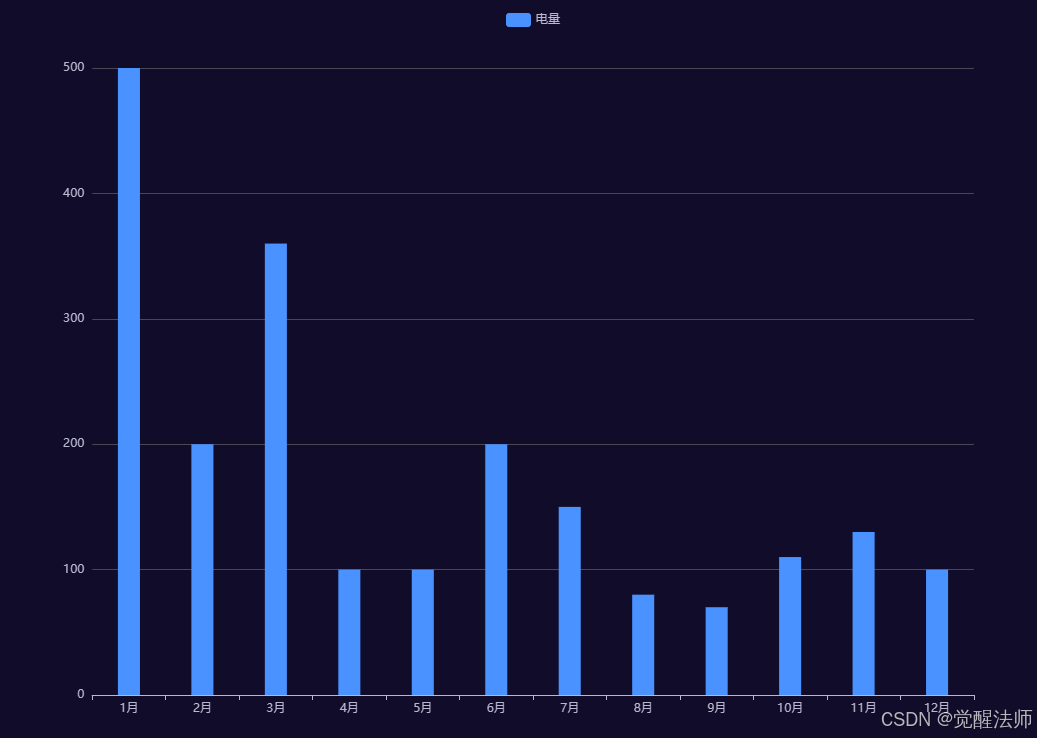
1.1 常规柱状图
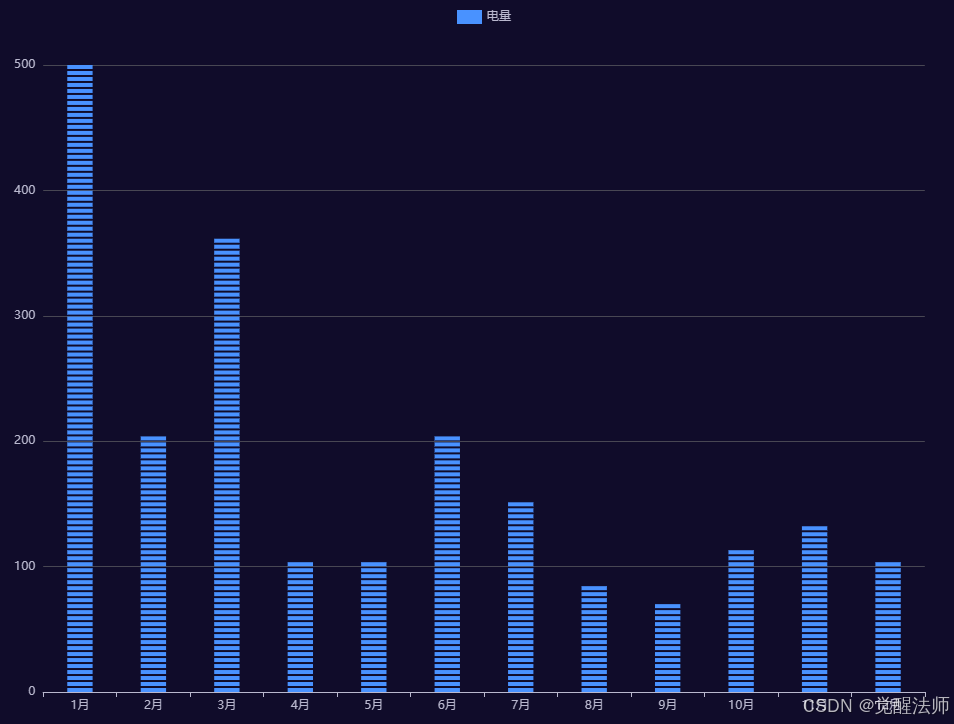
1.2 电量图表
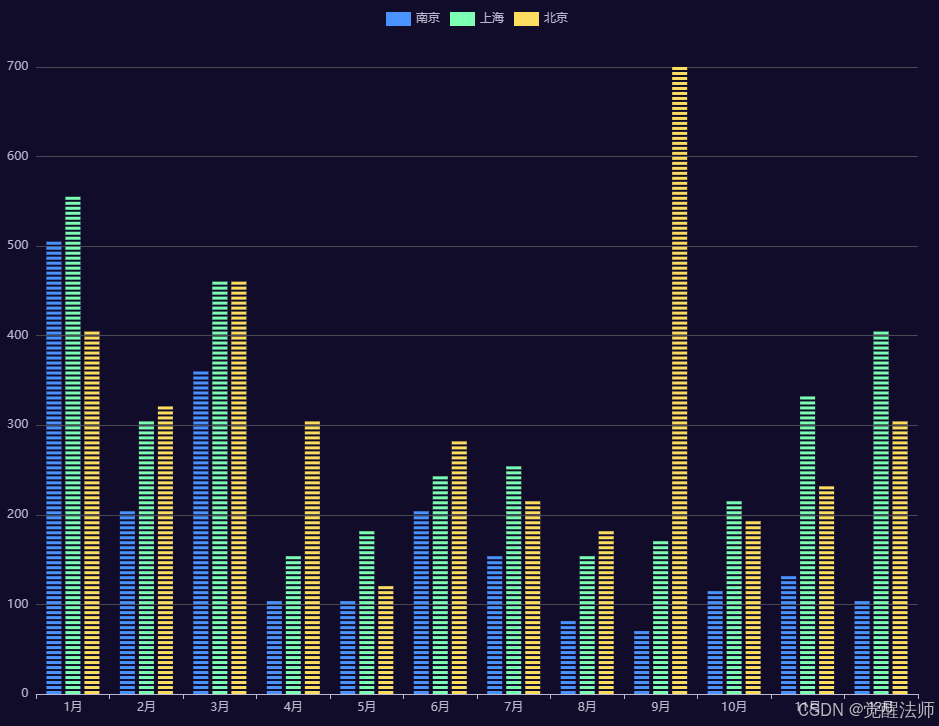
1.3 多系列电量图表
接下介绍,如何将常规的柱状图,变成第二张的电量柱状图表。
一、绘制图表
首页,将第一张常规的柱状图绘制出来,配置项代码如下:
option = {
xAxis: {
type: 'category',
data: ["1月","2月","3月","4月","5月","6月","7月","8月","9月","10月","11月","12月"]
},
yAxis: {
type: 'value'
},
legend: { },
series: [
{
data: [500, 200, 360, 100, 100, 200, 150, 80, 70, 110, 130, 100],
name: '电量',
type: 'bar',
barWidth: '30%'
}
]
}如果有些朋友只想看下效果,可以直接在EChart在线演示的编辑器中,将配置项代码贴入查看即可。常规柱状图表演示地址:Examples - Apache ECharts
当上述配置项执行后,一个常规的柱状图表就呈现出来了。接下来将对配置项进行一系列调整,让它呈现出电量图表。
二、绘制电量图表
2.1 pictorialBar象形柱图
将type="bar"改为type="pictorialBar"类型,来看看效果,配置项代码如下:
option = {
xAxis: {
type: 'category',
data: ["1月","2月","3月","4月","5月","6月","7月","8月","9月","10月","11月","12月"]
},
yAxis: {
type: 'value'
},
legend: { },
series: [
{
data: [500, 200, 360, 100, 100, 200, 150, 80, 70, 110, 130, 100],
name: '电量',
type: 'pictorialBar',
barWidth: '30%'
}
]
}此时页面效果变成如下效果,如下图:
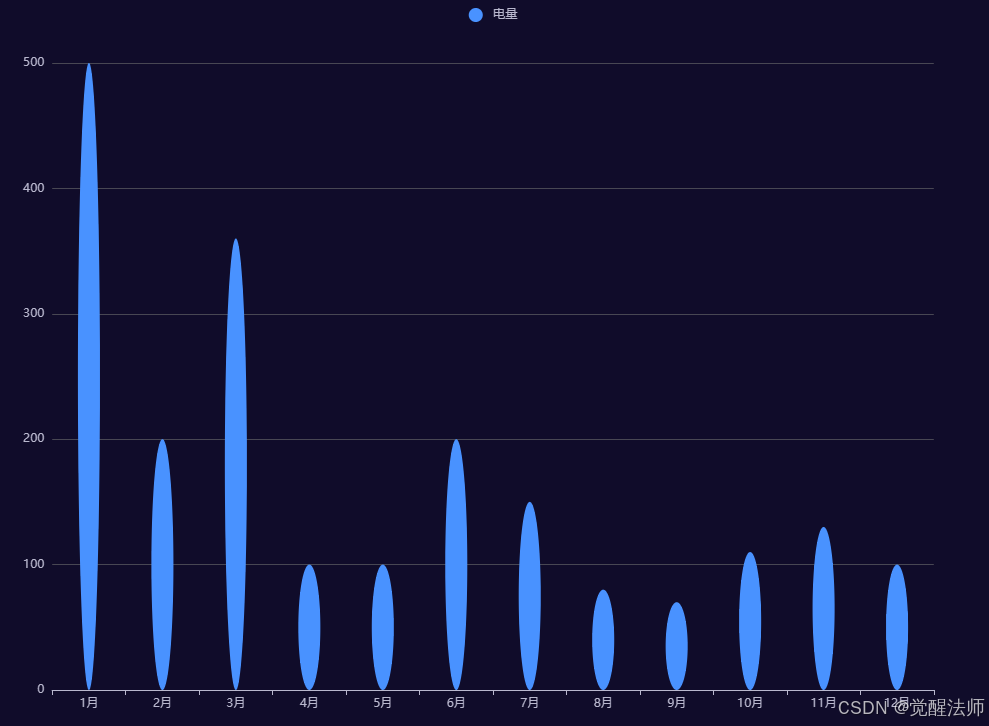
2.2 symbol图形类型
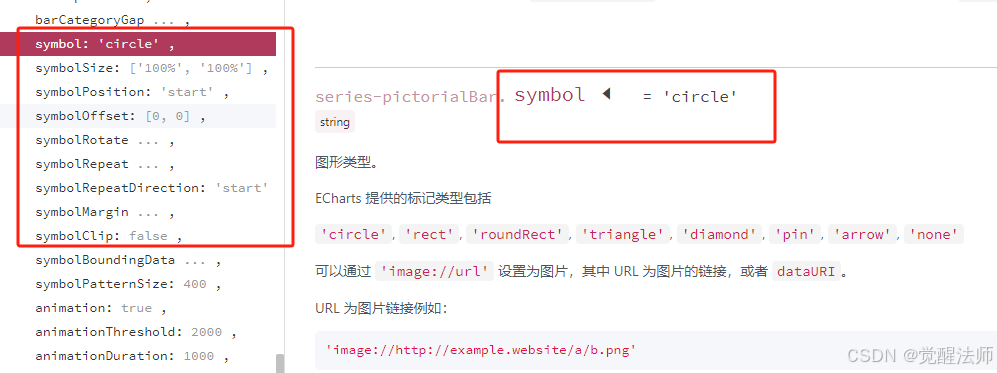
如上图,为此次绘制电量柱状图的相关参数,首先将symbol改为rect,再来看看效果。
配置项代码如下:
option = {
xAxis: {
type: 'category',
data: ["1月","2月","3月","4月","5月","6月","7月","8月","9月","10月","11月","12月"]
},
yAxis: {
type: 'value'
},
legend: { },
series: [
{
data: [500, 200, 360, 100, 100, 200, 150, 80, 70, 110, 130, 100],
name: '电量',
type: 'pictorialBar',
barWidth: '30%',
symbol: 'rect'
}
]
}会神奇的发现,图表又变回常规的柱状图样式了,如下图:
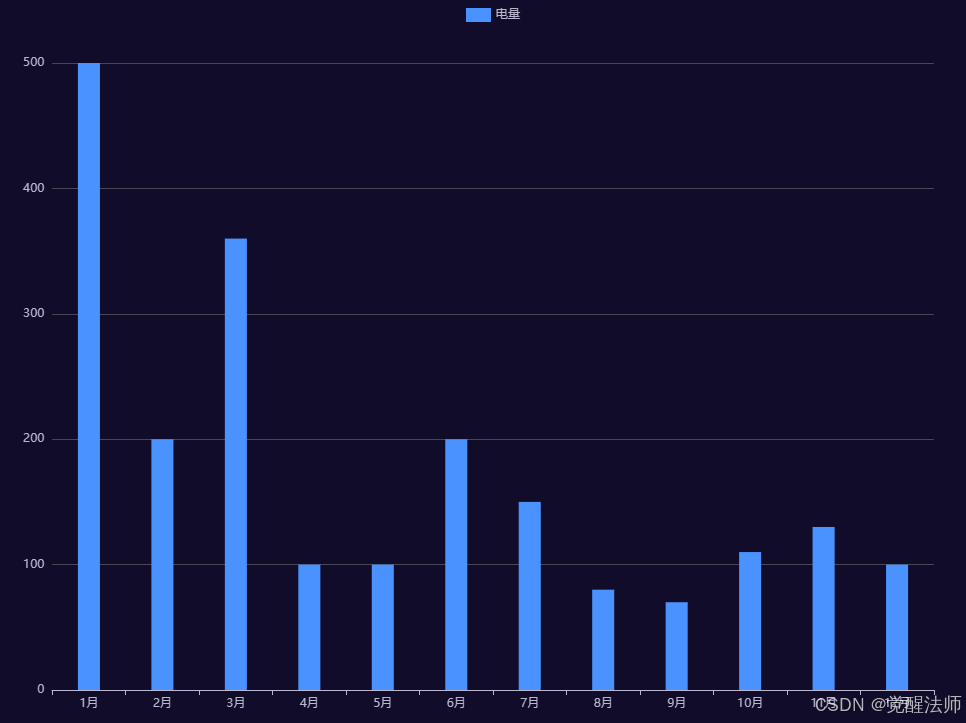
2.3 symbol图形切割
在修改配置项前,我们先来了解下两个参数,如下表:
| 序号 | 参数 | 描述 |
|---|---|---|
| 1 | symbolMargin | 图形的两边间隔(『两边』是指其数值轴方向的两边)。 可以是正值,表示间隔大;也可以是负数。当 symbolRepeat 被使用时,负数时能使图形重叠。 |
| 2 | symbolRepeat | 指定图形元素是否重复,值可为:false/null/undefined(不重复),true(使图形元素重复),a number(指定重复次数),'fixed'(一般在用于做背景时有用) |
接下来我们将它们加入到配置项中,再来看下效果。配置项代码如下:
option = {
xAxis: {
type: 'category',
data: ["1月","2月","3月","4月","5月","6月","7月","8月","9月","10月","11月","12月"]
},
yAxis: {
type: 'value'
},
legend: { },
series: [
{
data: [500, 200, 360, 100, 100, 200, 150, 80, 70, 110, 130, 100],
name: '电量',
type: 'pictorialBar',
barWidth: '30%',
symbol: 'rect',
symbolMargin: 1,
symbolRepeat: true
}
]
}页面效果开始出现切割效果,有点接近电量图的效果了,如下图:
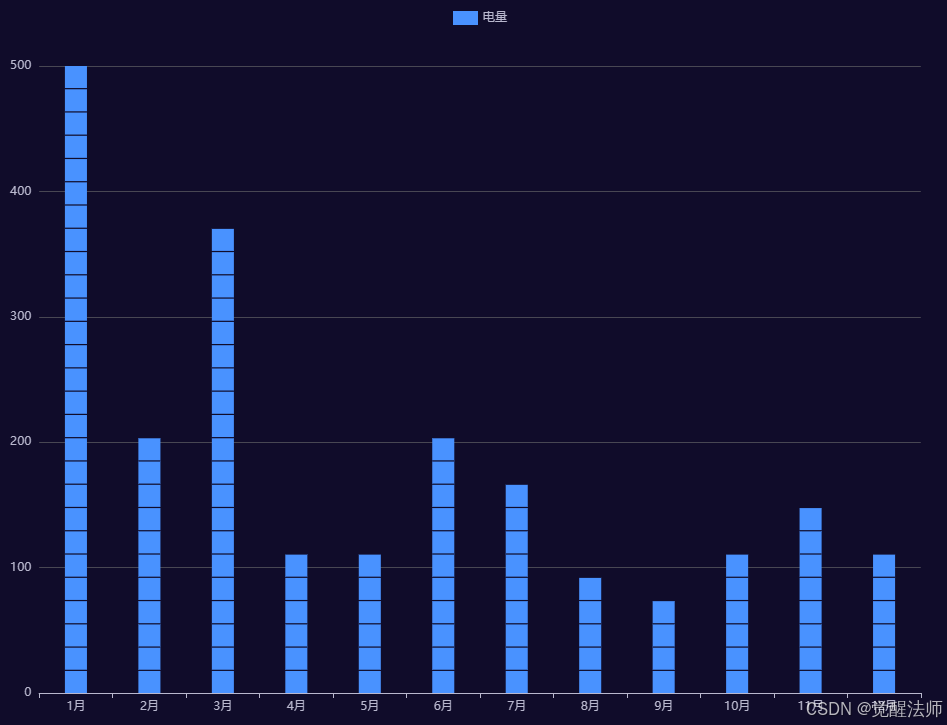
2.4 调整图形大小
上面切割后的图形,已经很接近电量图,只要将切割每个区域的高度调低点即可。那么则需要使用到symbolSize参数,它是用来修改图形大小的。

我们将电量柱状图的宽度调整为50%,调度设置为3,配置项代码如下:
option = {
xAxis: {
type: 'category',
data: ["1月","2月","3月","4月","5月","6月","7月","8月","9月","10月","11月","12月"]
},
yAxis: {
type: 'value'
},
legend: { },
series: [
{
data: [500, 200, 360, 100, 100, 200, 150, 80, 70, 110, 130, 100],
name: '电量',
type: 'pictorialBar',
symbol: 'rect',
symbolMargin: 1,
symbolRepeat: true,
symbolSize: ['50%', 3]
}
]
}此时页面则呈现出电量柱状图表效果了,如下图,:
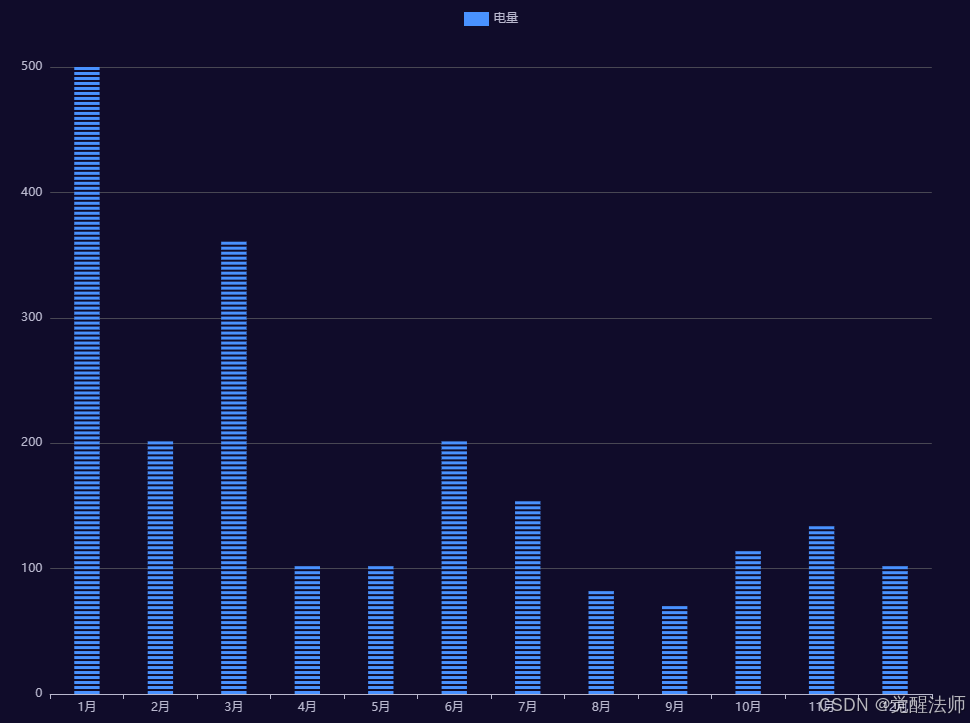
三、多系列电量图
在EChart中,可以通过丰富的API配置项,添加或修改相关参数,实现不同的图表效果。
3.1 绘制多系列电量图
当出现多系列的电量柱状图时,又是什么效果呢?此时我们将配项中数据更换为多系列,配置项代码如下:
option = {
xAxis: {
type: 'category',
data: ["1月","2月","3月","4月","5月","6月","7月","8月","9月","10月","11月","12月"]
},
yAxis: {
type: 'value'
},
legend: { },
series: [
{
data: [500, 200, 360, 100, 100, 200, 150, 80, 70, 110, 130, 100],
name: '南京',
type: 'pictorialBar',
symbol: 'rect',
symbolMargin: 1,
symbolRepeat: true,
symbolSize: ['30%', 3]
},
{
data: [550, 300, 460, 150, 180, 240, 250, 150, 170, 210, 330, 400],
name: '上海',
type: 'pictorialBar',
symbol: 'rect',
symbolMargin: 1,
symbolRepeat: true,
symbolSize: ['30%', 3]
},
{
data: [400, 320, 460, 300, 120, 280, 210, 180, 700, 190, 230, 300],
name: '北京',
type: 'pictorialBar',
symbol: 'rect',
symbolMargin: 1,
symbolRepeat: true,
symbolSize: ['30%', 3]
}
]
}页面效果:
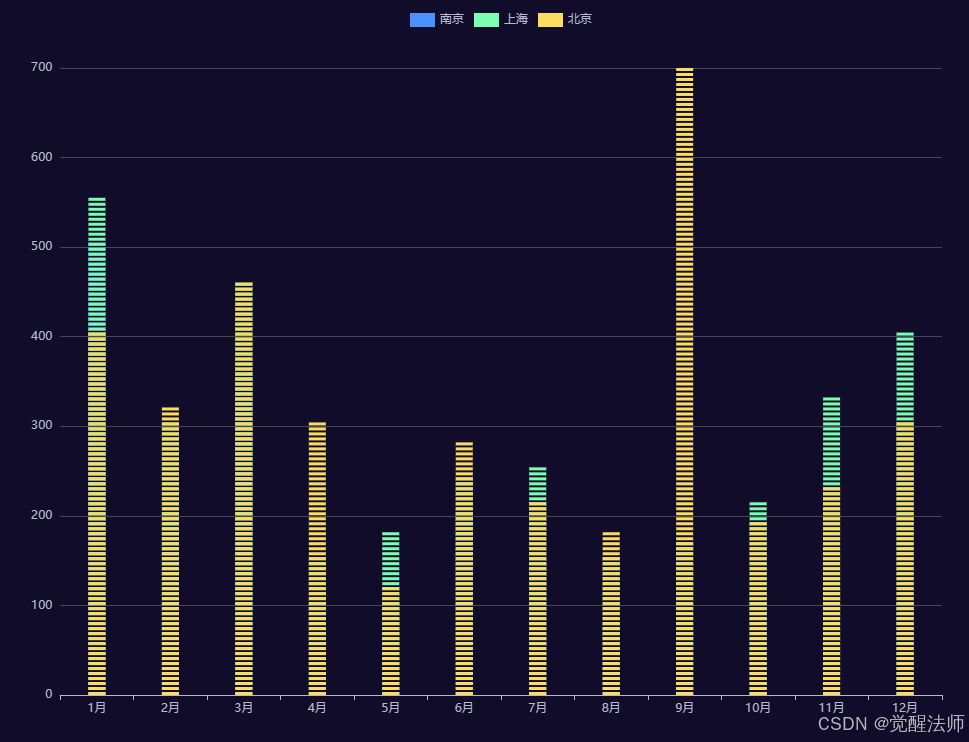
大家会发现,多系列图表都在同一基准柱上,简言而之,就是重叠到一起了;那么如何将它们分开呢?这则需要使用图形的定位位置,来解决这个问题。
3.2 图形的定位
每个象形图形根据基准柱的定位,是通过 symbolPosition、symbolOffset 来调整其于基准柱的相对位置。

这里使用symbolOffset对电量柱状图位置进行调整即可,注意的是,symbolOffset = [0, 0]中,第一个数值为X轴,第二个数值为Y轴;所以在修改每个柱状位置时,调整X轴即可,Y轴始终为0。
现在有三个系列数据,所将将第一个往右移'-50%',第二个不动,第三个往右移'50%',再来看下效果。 配置项代码如下:
option = {
xAxis: {
type: 'category',
data: ["1月","2月","3月","4月","5月","6月","7月","8月","9月","10月","11月","12月"]
},
yAxis: {
type: 'value'
},
legend: { },
series: [
{
data: [500, 200, 360, 100, 100, 200, 150, 80, 70, 110, 130, 100],
name: '南京',
type: 'pictorialBar',
symbol: 'rect',
symbolMargin: 1,
symbolRepeat: true,
symbolSize: ['30%', 3],
symbolOffset: ['-50%', 0]
},
{
data: [550, 300, 460, 150, 180, 240, 250, 150, 170, 210, 330, 400],
name: '上海',
type: 'pictorialBar',
symbol: 'rect',
symbolMargin: 1,
symbolRepeat: true,
symbolSize: ['30%', 3],
symbolOffset: [0, 0]
},
{
data: [400, 320, 460, 300, 120, 280, 210, 180, 700, 190, 230, 300],
name: '北京',
type: 'pictorialBar',
symbol: 'rect',
symbolMargin: 1,
symbolRepeat: true,
symbolSize: ['30%', 3],
symbolOffset: ['50%', 0]
}
]
};页面效果如下图:
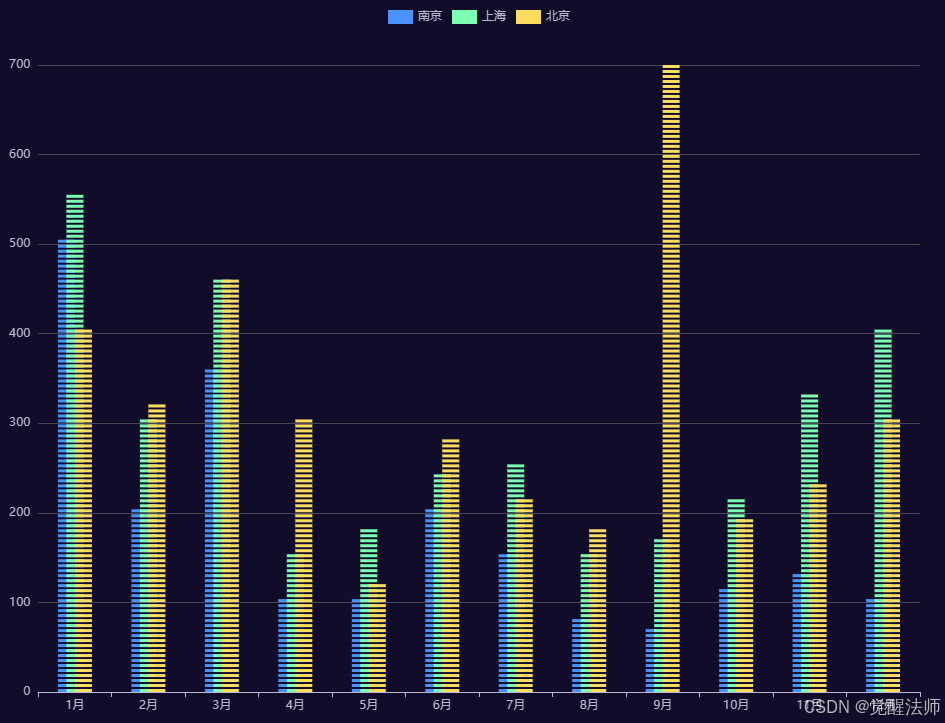
此时,电量柱状图还是重叠在一起,这是因为我们在设置symbolSize时,使用了百分比,使宽度过和位置位置出现重叠。所以,我们需要将symbolSize和symbolOffset一起调整下,改为实际宽度和位置距离的像素值。
将电量柱状图的宽度设置为20,第一个往左移-20px,第三个往右移20px,配置项代码如下:
const symbolWidth = 20
option = {
xAxis: {
type: 'category',
data: ["1月","2月","3月","4月","5月","6月","7月","8月","9月","10月","11月","12月"]
},
yAxis: {
type: 'value'
},
legend: { },
series: [
{
data: [500, 200, 360, 100, 100, 200, 150, 80, 70, 110, 130, 100],
name: '南京',
type: 'pictorialBar',
symbol: 'rect',
symbolMargin: 1,
symbolRepeat: true,
symbolSize: [symbolWidth, 3],
symbolOffset: [`-${symbolWidth}px`, 0]
},
{
data: [550, 300, 460, 150, 180, 240, 250, 150, 170, 210, 330, 400],
name: '上海',
type: 'pictorialBar',
symbol: 'rect',
symbolMargin: 1,
symbolRepeat: true,
symbolSize: [symbolWidth, 3],
symbolOffset: [0, 0]
},
{
data: [400, 320, 460, 300, 120, 280, 210, 180, 700, 190, 230, 300],
name: '北京',
type: 'pictorialBar',
symbol: 'rect',
symbolMargin: 1,
symbolRepeat: true,
symbolSize: [symbolWidth, 3],
symbolOffset: [`${symbolWidth}px`, 0]
}
]
}页面效果如下图:
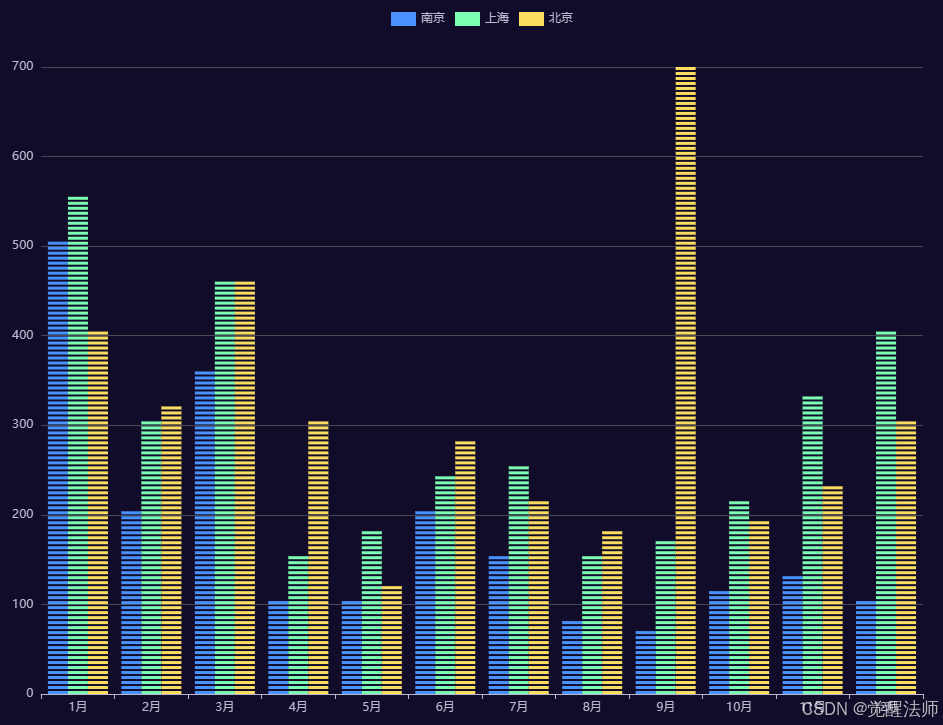
现在,三个系列的电量柱状图则沿自己的基准柱的相对位置显示。
不过都挨一起还是不太美观,所以需要将它们中间设置出点间隙来;可以将第一个电量柱状图多往左移4像素,第二个电量柱状图往右多移4像素;并且将原来电量柱状宽度调为15。
配置项代码如下:
const symbolWidth = 15 // 电量柱状宽度
const gap = 4 // 间隙
option = {
xAxis: {
type: 'category',
data: ["1月","2月","3月","4月","5月","6月","7月","8月","9月","10月","11月","12月"]
},
yAxis: {
type: 'value'
},
legend: { },
series: [
{
data: [500, 200, 360, 100, 100, 200, 150, 80, 70, 110, 130, 100],
name: '南京',
type: 'pictorialBar',
symbol: 'rect',
symbolMargin: 1,
symbolRepeat: true,
symbolSize: [symbolWidth, 3],
symbolOffset: [`-${symbolWidth + gap}px`, 0]
},
{
data: [550, 300, 460, 150, 180, 240, 250, 150, 170, 210, 330, 400],
name: '上海',
type: 'pictorialBar',
symbol: 'rect',
symbolMargin: 1,
symbolRepeat: true,
symbolSize: [symbolWidth, 3],
symbolOffset: [0, 0]
},
{
data: [400, 320, 460, 300, 120, 280, 210, 180, 700, 190, 230, 300],
name: '北京',
type: 'pictorialBar',
symbol: 'rect',
symbolMargin: 1,
symbolRepeat: true,
symbolSize: [symbolWidth, 3],
symbolOffset: [`${symbolWidth + gap}px`, 0]
}
]
}页面效果如下图:
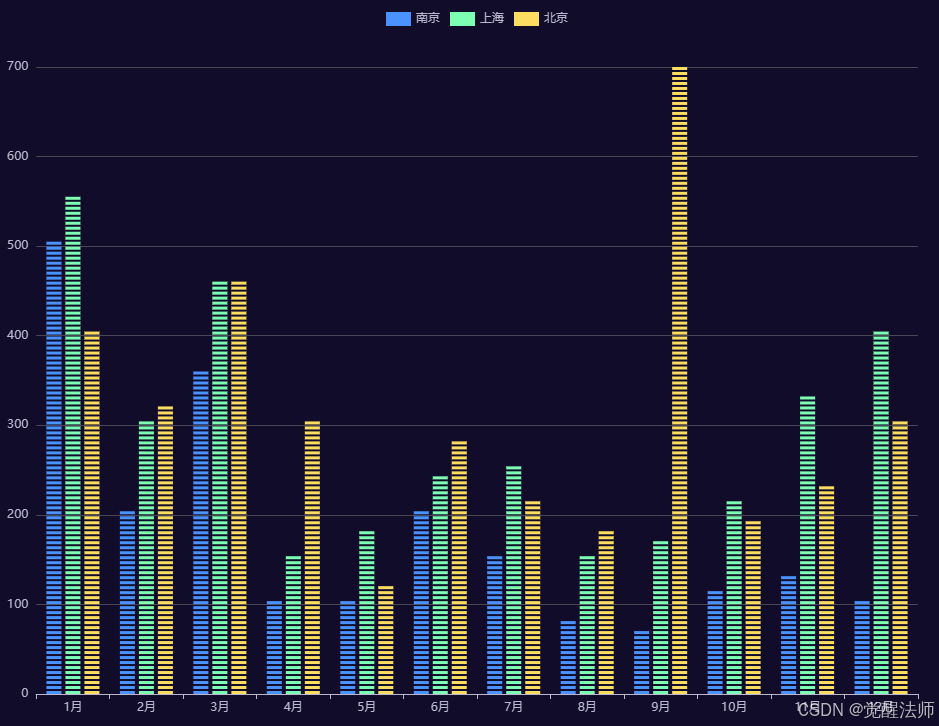
此篇则讲到这里,希望对大家有所帮助!